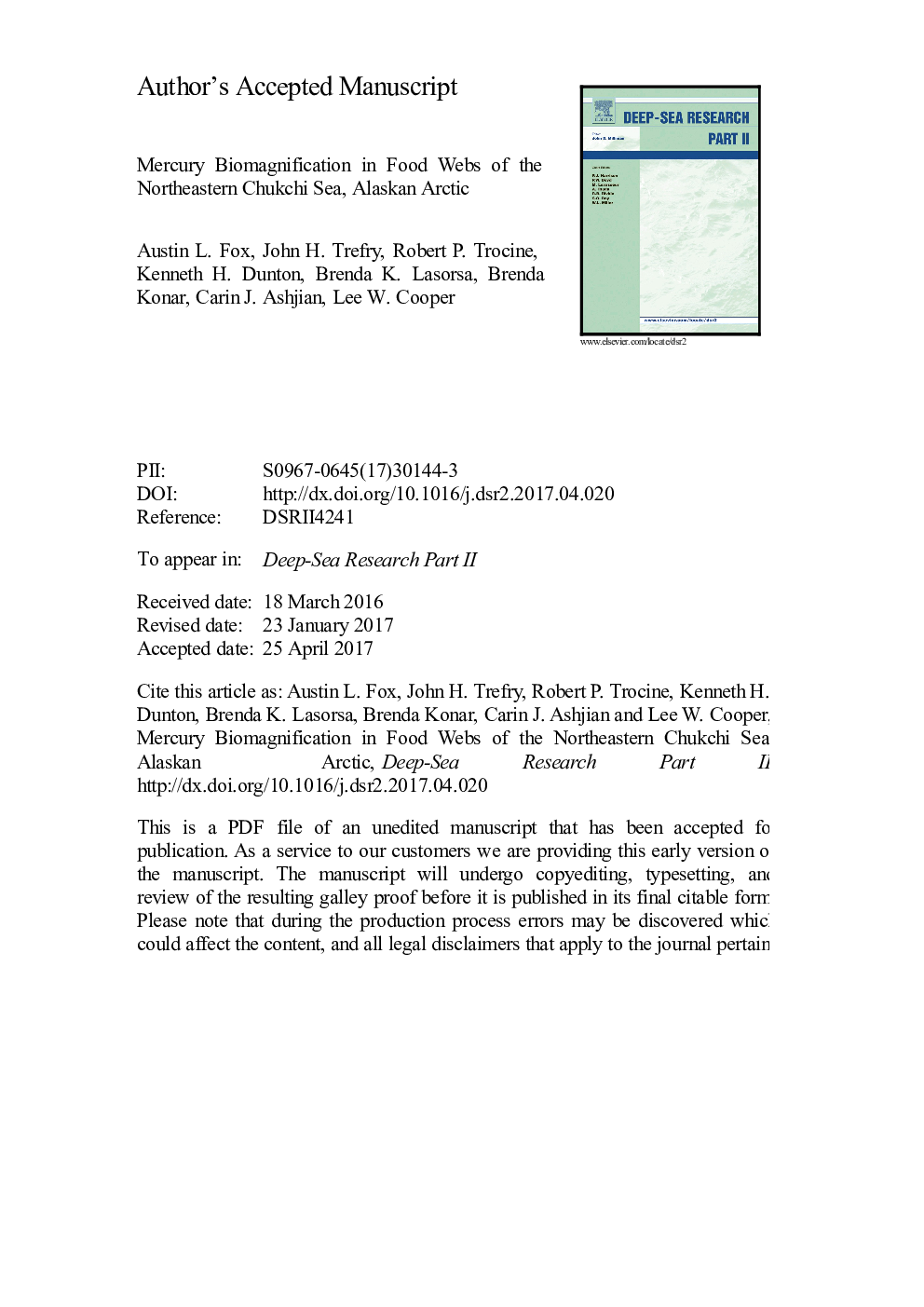| کد مقاله | کد نشریه | سال انتشار | مقاله انگلیسی | نسخه تمام متن |
|---|---|---|---|---|
| 5764769 | 1626398 | 2017 | 73 صفحه PDF | دانلود رایگان |
عنوان انگلیسی مقاله ISI
Mercury biomagnification in food webs of the northeastern Chukchi Sea, Alaskan Arctic
ترجمه فارسی عنوان
زیست توده جیوه در شبکه های غذای دریای چوکچوی شمال شرقی، قطب شمال آلاسکا
دانلود مقاله + سفارش ترجمه
دانلود مقاله ISI انگلیسی
رایگان برای ایرانیان
کلمات کلیدی
NECscold vapor atomic fluorescence spectrometryTMSCVAFSDIWNISTTEFmmHgMDLANCOVAPDBPOMDOCTOCSRMTHg - THGdeionized water - آب یونیزه شدهstandard deviation - انحراف معیارanalysis of covariance - تجزیه و تحلیل کوواریانسMercury - جیوهMercury (Hg) - جیوه (Hg)Inorganic mercury - جیوه معدنیstandard error - خطای استانداردdegrees of freedom - درجه آزادیChukchi Sea - دریای چوکچویBiomagnification - زیست انباشتگی افزایشی، بزرگنمایی زیستیTrophic level - سطح تغذیهArctic - قطب شمالParticulate organic matter - ماده آلی آلیMethod Detection Limit - محدودیت تشخیص روشstandard reference material - مرجع استانداردNational Institute of Standards and Technology - موسسه ی ملی استانداردها و تکنولوژیdry weight - وزن خشکDissolved organic carbon - کربن آلی حل شدهTotal mercury - کل جیوهTotal organic carbon - کل کربن آلی
موضوعات مرتبط
مهندسی و علوم پایه
علوم زمین و سیارات
زمین شناسی
چکیده انگلیسی
Predictive tools and a large new dataset for the northeastern Chukchi Sea (NECS) are used here to help identify regional differences and potential future shifts in the magnitude of Hg biomagnification in the Arctic. At the base of the food web in the NECS, concentrations of total mercury (THg) in phytoplankton (20-µm mesh) ranged from 4-42 ng gâ1 dry weight, partly in response to variations in algal biomass and water temperature. A >3-fold increase in monomethylmercury (MMHg) was observed in zooplankton (4.3±0.7 ng gâ1) relative to phytoplankton (<1.5 ng gâ1), even though concentrations of THg in zooplankton (150-µm mesh) were not significantly different than in phytoplankton. Concentrations and % MMHg increased with trophic level (TL) by >150-fold and from <10 to >85%, respectively, from phytoplankton to muscle in the whelk Plicifusus kroeyeri (279 ng gâ1, TL 4.5). For muscle tissue in 10 species plus whole phytoplankton and zooplankton, the trophic magnification slope (TMS) for MMHg (log10[MMHg]=m(δ15N)+b; where m=TMS) was 0.23±0.02 (SE). No significant differences in TMS were found for the NECS plus three other studies from the eastern Canadian Arctic (average TMS=0.24±0.02). Nevertheless, all data for MMHg in biota from the NECS plotted below the combined best fit line for all four studies. Results from an ANCOVA showed that statistically different (p=0.001) intercept values (b), not TMS, best explained the >2-fold lower concentrations of MMHg in biota from the NECS (b=â1.85) relative to the same species from the eastern Canadian Arctic (b=â1.29). Future changes that affect bioaccumulation of MMHg in the Arctic may impact the biomagnification equation by shifting the TMS, intercept or both. The intercept is more likely to respond to changes in productivity and concentrations of dissolved Hg whereas the TMS may respond to changing growth rates due to fluctuations in productivity and food availability. In either case, small changes in the intercept or TMS coincide with predictably large increases or decreases in MMHg concentrations in apex predators.
ناشر
Database: Elsevier - ScienceDirect (ساینس دایرکت)
Journal: Deep Sea Research Part II: Topical Studies in Oceanography - Volume 144, October 2017, Pages 63-77
Journal: Deep Sea Research Part II: Topical Studies in Oceanography - Volume 144, October 2017, Pages 63-77
نویسندگان
Austin L. Fox, John H. Trefry, Robert P. Trocine, Kenneth H. Dunton, Brenda K. Lasorsa, Brenda Konar, Carin J. Ashjian, Lee W. Cooper,
